Haben Sie schon einmal versucht, einen Ihrer WordPress-Beiträge zu öffnen, nur um von einem 404-Fehler begrüßt zu werden? Manchmal erleben wir das, wenn wir an unseren eigenen WordPress-Seiten arbeiten oder unseren Benutzern helfen
Dieser Fehler tritt auf, wenn Sie auf Ihren WordPress-Administrationsbereich und Ihr Blog zugreifen können, aber wenn Sie versuchen, einen bestimmten Beitrag zu öffnen, erhalten Sie die Meldung „404 Not Found“.
Es kann frustrierend sein, wenn Ihre Inhalte scheinbar verschwinden, aber wir haben einige Lösungen gefunden, um dieses Problem zu beheben. In dieser vollständigen Anleitung zeigen wir Ihnen, wie Sie WordPress-Beiträge mit 404-Fehlern beheben können.
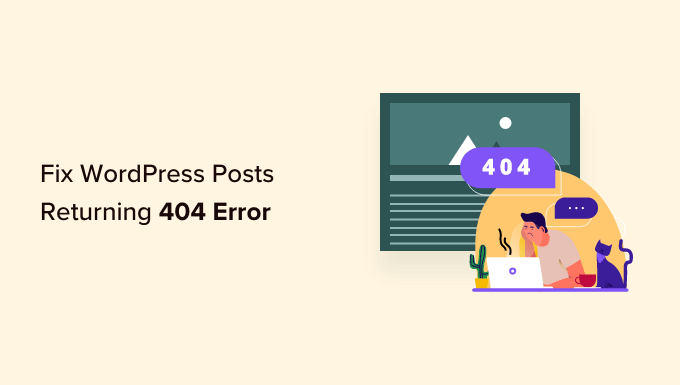
Warum erhalten meine WordPress-Beiträge einen 404-Fehler?
Es gibt mehrere Gründe, warum Ihre Beiträge in WordPress einen 404 „Seite nicht gefunden“-Fehler anzeigen. Diese können sein:
- Konflikte mit Plugins oder Themes: Manchmal können Plugins oder Themes, die Sie auf Ihrer Website installiert haben, die Handhabung von Permalinks durch WordPress beeinträchtigen. Dies kann zu fehlerhaften Links und 404-Fehlern führen.
- Probleme mit benutzerdefiniertem Code: Wenn Sie Ihrer Website benutzerdefinierten Code hinzugefügt haben, kann es sein, dass der Code Fehler enthält, die sich auf Permalinks auswirken oder andere Konflikte verursachen, was zu 404-Fehlern für Ihre Beiträge führt.
- Probleme mit Ihrer .htaccess-Datei: Die .htaccess-Datei spielt eine Rolle dabei, wie WordPress URLs strukturiert. Wenn diese Datei beschädigt ist oder fehlt, kann dies zu 404-Fehlern für Ihre Beiträge oder Seiten führen.
Wie man alle WordPress-Beiträge mit 404-Fehlern findet
Bevor wir zu den Lösungen kommen, wäre es gut, herauszufinden, ob der Fehler nur bei einem oder zwei Beiträgen oder bei mehreren Beiträgen auftritt. Auf diese Weise können Sie den Umfang des Problems bestimmen und die am besten geeignete Lösung wählen.
Eine einfache Möglichkeit, dies herauszufinden, ist die Verwendung der Google Search Console. Wenn Sie Ihre Website noch nicht bei Google Search Console angemeldet haben, lesen Sie unseren Leitfaden zum Hinzufügen Ihrer WordPress-Website zu Google Search Console.
Sobald der Google-Bot Ihre Website gecrawlt und indexiert hat, liefert Ihnen die Google Search Console detaillierte Informationen über die Leistung Ihrer Website, einschließlich aller 404-Fehler, auf die sie stößt.
Um herauszufinden, bei welchen Beiträgen 404-Fehler auftreten, können Sie sich im Dashboard der Search Console anmelden. Navigieren Sie dann zum Bericht „Seiten“ und Sie sehen eine detaillierte Liste aller Fehler.
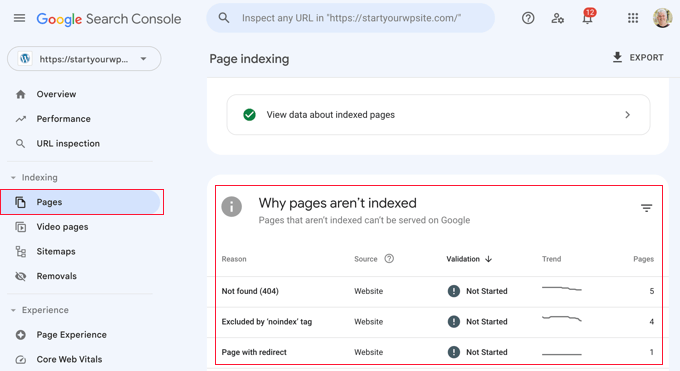
Weitere Informationen finden Sie in unserer Liste mit Tipps für die Verwendung der Google Search Console zur Steigerung des Website-Traffics, die auch einige Tipps zur Behebung von 404-Fehlern mit dem Tool enthält.
Sehen wir uns also an, wie man WordPress-Beiträge mit 404-Fehlern beheben kann. Sie können die Links unten verwenden, um direkt zu den verschiedenen Lösungen zu springen:
Keine Zeit, 404-Fehler selbst zu beheben? WPBeginner Pro Services kann helfen! Mit unserem erschwinglichen WordPress-Notfallsupport können Sie Experten beauftragen, 404-Fehler, defekte Links, Weiterleitungsprobleme und vieles mehr zu beheben. Hören Sie auf, sich über WordPress-Probleme zu ärgern und lassen Sie sie beheben! Vereinbaren Sie noch heute einen Notfall-Support für WordPress!
Methode 1: Suchen Sie nach Plugin- oder Theme-Konflikten und benutzerdefinierten Code-Problemen
Manchmal können Plugins, Themes oder benutzerdefinierter Code, den Sie zu Ihrer WordPress-Website hinzugefügt haben, Permalinks beeinträchtigen oder Konflikte verursachen, die zu 404-Fehlern führen. Wir haben das sogar schon selbst erlebt, als wir Tools auf unserer Demo-Website getestet haben.
Eine Möglichkeit, dieses Problem zu lösen, besteht darin, Plugins vorübergehend zu deaktivieren. Plugins können manchmal stören, wie WordPress mit Links umgeht.
Nachdem Sie die Plugins deaktiviert haben, können Sie sie nacheinander reaktivieren und dabei überprüfen, ob der 404-Fehler nach der Aktivierung der einzelnen Plugins erneut auftritt. Wenn der Fehler nach der Aktivierung eines bestimmten Plugins auftritt, könnte dieses der Übeltäter sein.
Sie können dann eine schnelle Google-Suche nach Lösungen für dieses Plugin durchführen oder den Plugin-Entwickler um Unterstützung bitten.
Auch Ihr WordPress-Theme könnte die Ursache für den Konflikt sein.
Um das zu überprüfen, können Sie vorübergehend zu einem Standard-WordPress-Theme wie Twenty Twenty-Three oder Twenty Twenty-Four wechseln. Dazu müssen Sie nur auf Darstellung „ Themes gehen und bei einem Standard-Theme auf „Aktivieren“ klicken.

Wenn der 404-Fehler mit dem Standard-Theme verschwindet, deutet dies auf einen möglichen Konflikt mit Ihrem aktuellen Theme hin. Sie können dann versuchen, das Problem mit dem Theme zu beheben oder ein anderes Theme zu verwenden.
In unserer Expertenauswahl der beliebtesten WordPress-Themes finden Sie Empfehlungen.
Wenn Sie kürzlich Codeschnipsel in Ihre Website eingefügt haben, kann es sein, dass der Code Fehler enthält, die die 404-Fehler verursachen. Schauen Sie sich den hinzugefügten Code genau an und prüfen Sie, ob Sie Fehler finden können.
Der sicherste Weg, Code-Schnipsel in WordPress einzufügen, ist das WPCode-Plugin. Mit diesem Plugin können Sie benutzerdefinierten Code einfügen, ohne direkt mit den Themadateien zu arbeiten, wodurch das Risiko, dass Ihre Website beschädigt wird, verringert wird.
Und wenn WPCode einen Fehler in Ihrem Code entdeckt, wird das Snippet automatisch deaktiviert und Sie werden aufgefordert, es zu überprüfen. Sie können auch den Testmodus verwenden, um zu prüfen, ob Ihr Code funktioniert, bevor Sie ihn auf Ihre Live-Website übertragen.
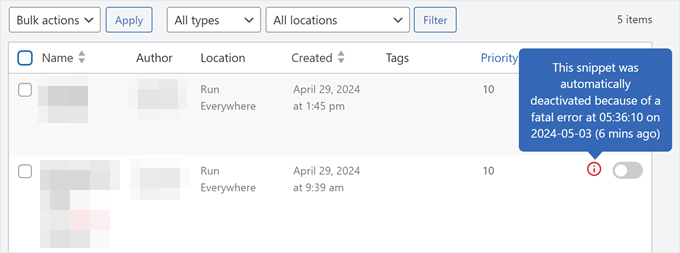
Wenn keine dieser Lösungen funktioniert, fahren Sie mit der nächsten Methode fort, bei der wir Ihre Permalink-Einstellungen überprüfen werden.
Methode 2: Reparieren Sie Ihre Permalink-Einstellungen
WordPress-Beiträge können aufgrund von Problemen mit Rewrite-Regeln in Ihrer .htaccess-Datei 404-Fehler zurückgeben. In den meisten Fällen können Sie das Problem beheben, indem Sie Ihre Permalink-Einstellungen aktualisieren.
Gehen Sie einfach zu Einstellungen “ Permalinks in Ihrem WordPress-Admin und klicken Sie auf die Schaltfläche „Änderungen speichern“.
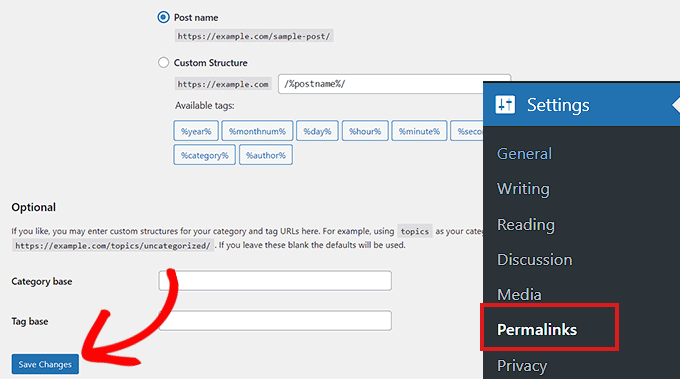
Es ist nicht notwendig, die Permalink-Einstellungen selbst zu ändern. Dadurch werden Ihre Permalink-Einstellungen aktualisiert und die Rewrite-Regeln geleert.
In den meisten Fällen behebt diese Lösung den 404-Fehler bei WordPress-Beiträgen. Wenn es bei Ihnen jedoch nicht funktioniert, müssen Sie wahrscheinlich Ihre .htaccess-Datei manuell aktualisieren.
Methode 3: Aktualisieren der WordPress-.htaccess-Datei
Bevor Sie beginnen, sollten Sie eine Sicherungskopie Ihrer WordPress.htaccess-Datei erstellen. Wenn etwas schief geht, können Sie die ursprüngliche Datei leicht wiederherstellen.
Nun müssen Sie eine Verbindung zu Ihrem Server herstellen, indem Sie einen FTP-Client wie FileZilla oder die Dateimanager-App in Ihrem WordPress-Hosting-Dashboard verwenden.
Als Nächstes müssen Sie die Datei .htaccess finden und bearbeiten, die sich am selben Ort wie die Ordner /wp-content/ und /wp-includes/ befindet.
Klicken Sie einfach mit der rechten Maustaste auf die Datei und wählen Sie „Dateiberechtigungen“.
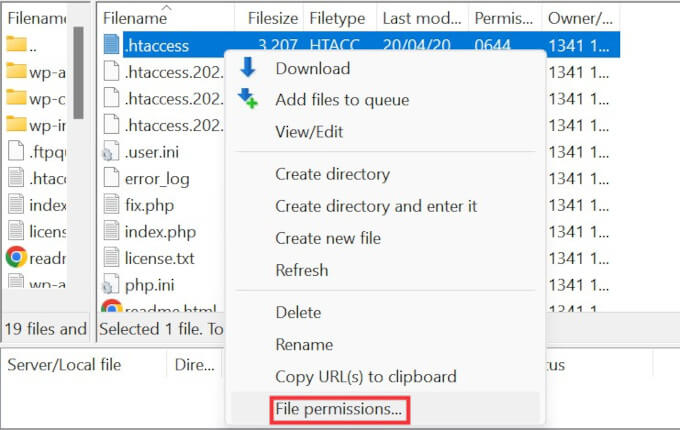
Sie können die Datei schreibbar machen, indem Sie ihre Berechtigungen auf 666 ändern.
Geben Sie einfach „666“ in das Feld „Numerischer Wert“ ein und klicken Sie dann auf „OK“.
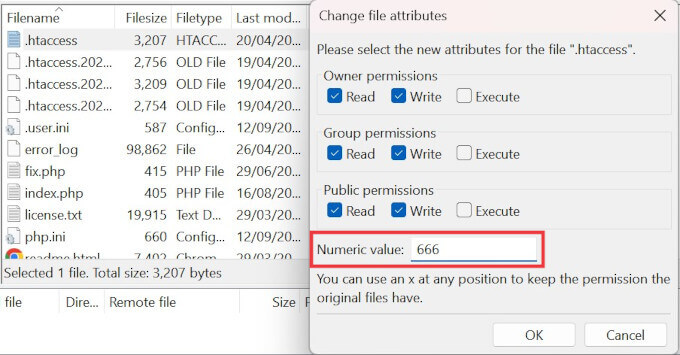
Dann müssen Sie die Schritte der ersten Methode unseres Tutorials wiederholen. Vergessen Sie danach nicht, die Berechtigungen wieder auf 660 zu ändern.
Sie können die Datei auch bearbeiten und ihr Code hinzufügen.
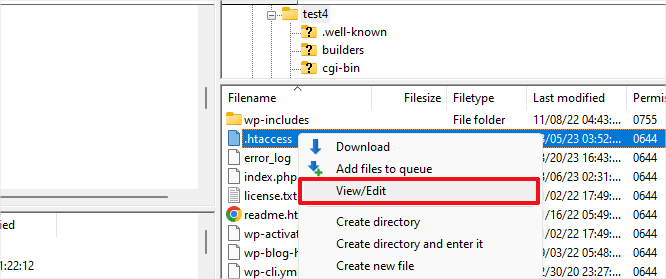
Nachdem Sie die .htaccess-Datei mit einem Texteditor geöffnet haben, fügen Sie einfach diesen Code ein:
# BEGIN WordPress
<IfModule mod_rewrite.c>
RewriteEngine On
RewriteBase /
RewriteRule ^index\.php$ - [L]
RewriteCond %{REQUEST_FILENAME} !-f
RewriteCond %{REQUEST_FILENAME} !-d
RewriteRule . /index.php [L]
</IfModule>
# END WordPress
Methode 4: Kontaktieren Sie Ihren Hosting-Anbieter
Wenn keine der oben genannten Lösungen das Problem der 404-Fehler bei WordPress-Beiträgen behoben hat, empfehlen wir Ihnen, sich an Ihren WordPress-Hosting-Anbieter zu wenden. Möglicherweise liegt ein Fehler auf dessen Seite vor, oder er kann Ihnen bei der Fehlerbehebung helfen.
Bitte lesen Sie auch unseren Leitfaden, wie Sie richtig nach WordPress-Support fragen und diesen auch erhalten.
Methode 5: Aktivieren Sie mod-rewrite (lokale WordPress-Installation)
Wenn Sie einen lokalen Server zu Testzwecken verwenden, müssen Sie mod_rewrite in der Apache-Konfiguration Ihrer MAMP-, WAMP- oder XAMPP-Site aktivieren.
Dies ermöglicht WordPress, saubere URLs zu generieren und den 404-Fehler für Beiträge und Seiten auf Ihrem lokalen Server zu vermeiden.
Wie Sie dies tun, hängt von der von Ihnen verwendeten Plattform ab. Benutzer von XAMPP können ihr Kontrollpanel öffnen und unter „Aktionen“ auf die Schaltfläche „Konfig“ klicken. Wählen Sie dann „Apache (httpd.conf)“.
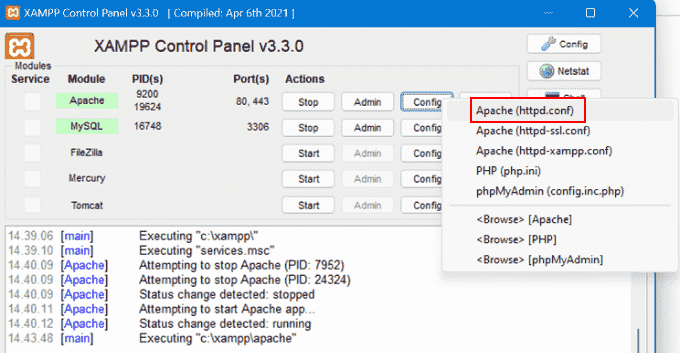
Als Nächstes müssen Sie diese Zeile #LoadModule rewrite_module modules/mod_rewrite.so finden und das ‚#‘ entfernen, um sie zu entkommentieren.
Dadurch wird mod_rewrite geladen.
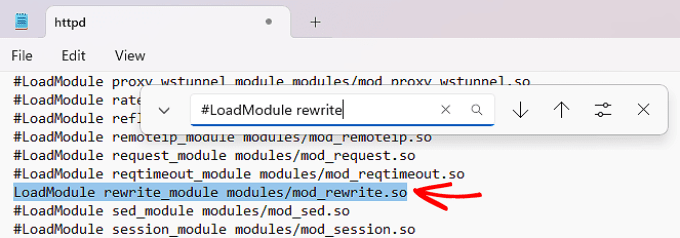
Suchen Sie dann alle Instanzen von AllowOverride None und ändern Sie sie in AllowOverride All.
Der Wert „Alle“ bedeutet, dass alle Direktiven überschrieben werden können.
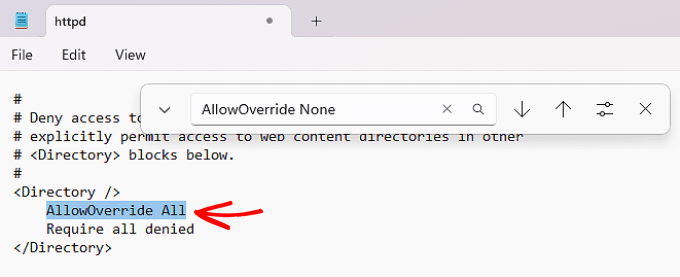
Danach können Sie die Datei httpd.conf speichern und schließen. Danach klicken Sie im XAMPP-Kontrollfeld auf „Stop“ für das Apache-Modul und erneut auf „Start“, um es neu zu starten.
Gehen Sie dann zurück zu Ihrem Admin-Dashboard, um zu sehen, ob Ihre Permalinks funktionieren.
Video-Anleitung
Wenn Sie eine visuelle Anleitung benötigen, sehen Sie sich einfach das folgende Video an.
Wir hoffen, dass dieser Artikel Ihnen geholfen hat, die 404-Fehler in WordPress zu beheben. Vielleicht interessieren Sie sich auch für unseren Leitfaden zu den häufigsten WordPress-Fehlern und deren Behebung sowie für unsere Expertenauswahl der besten WordPress-Plugins für das Wachstum Ihrer Website.
Wenn Ihnen dieser Artikel gefallen hat, dann abonnieren Sie bitte unseren YouTube-Kanal für WordPress-Videotutorials. Sie können uns auch auf Twitter und Facebook finden.





Moinuddin Waheed
This is one of the most occuring error for wordpress websites.
this is really frustrating as it seems to get stuck and leading to nowhere.
I have solved the issue by saving the permalink.
I didn’t know about the other steps.
I really appreciate the efforts to make it holistic by including all the steps to resolve this error.
WPBeginner Support
Glad we could share the other options
Admin
mohadese esmaeeli
Hello. The 404 error can be really frustrating, and we’ve all encountered it at least once. The situation becomes challenging when everything appears to be correct, there are no broken links, yet the 404 error persists. I faced this issue once, and it was resolved by adjusting the permalink settings.
amir
Hi
in my case, a plugin named as „WebP Express“ create a htaccess file in uploads folder that restrict my access to some images.
try rename or remove it and see if the problem still exist.
WPBeginner Support
Thank you for sharing this suggestion to check for multiple htaccess files.
Admin
Eriab Nsereko
Syed & the team u saved my whole entire day! My homepage was actually loading well.. but the other pages couldn’t load. So, I pasted the code in my .htaccess file and it did absolutely like magic.
# BEGIN WordPress
RewriteEngine On
RewriteBase /
RewriteRule ^index\.php$ – [L]
RewriteCond %{REQUEST_FILENAME} !-f
RewriteCond %{REQUEST_FILENAME} !-d
RewriteRule . /index.php [L]
# END WordPress
WPBeginner Support
Glad we could help!
Admin
David Helleskov Fønsbo
Thanks – None of the suggested solutions did work for me. Looks like the typical permalink error but it isn’t.
Saving permalink again does not create a new .htaccess.
WPBeginner Support
If none of the methods in our guide are working for you, please reach out to your hosting provider and they should be able to help fix the issue.
Admin
Victor
The updating permalinks fix worked. Fastest solution ever. Thank you for writing this piece
WPBeginner Support
You’re welcome, glad our guide was helpful!
Admin
Julie
Thank you for the quick fix! Appreciate the help.
WPBeginner Support
You’re welcome, glad our guide could help you!
Admin
Frank Thomas
Thank you for this post. I was missing the .htaccess files after moving sites and of course the wordpress code in them. I’ve replaced it all and voila! We are live at 5. Thanks.
WPBeginner Support
You’re welcome, glad to hear the guide helped!
Admin
anand
i have try to your guideline but not working my website again showing same error 404
WPBeginner Support
If none of the recommendations from our guide could solve your error, please reach out to your hosting provider and they should be able to take a look and help!
Admin
Harald
Hi,
saving permalink helped me too, but it keeps returning over and over again after some days.
I have no clue what causes it.
WPBeginner Support
If it is a constantly recurring error, we would recommend reaching out to your hosting provider and they can either look at their error logs for the site or keep an eye on your site for the specific error causing the problem.
Admin
Mete
Thank you very much.solved my problem
WPBeginner Support
Glad our guide was helpful!
Admin
Emmanuel
This is my lifesaver. My site is working fine after modifying the .htaccess files.
Thanks a ton!
WPBeginner Support
Glad our guide could help!
Admin
Jon
For me the problem was I forced a redirect from mydomain.com to ww.mydomain.com, but in wordpress the site URL said mydomain.com. After changing the redirection to ww.mydomain.com -> mydomain.com everything worked.
WPBeginner Support
Thanks for sharing this for those who may also have this issue!
Admin
Mario Nwolisah
Thank you! It worked. I really appreciate.
WPBeginner Support
Glad our article was helpful!
Admin
Jess
Thank you – this saved me!
WPBeginner Support
Happy to hear our guide could help!
Admin
Cristian
Thank you, it works for me!!!
WPBeginner Support
Glad our recommendations were able to assist!
Admin
Samir K Al Busaidy
I was panicking and thinking that my website was hacked or had malware. As I read your writing and you wrote not to worry, I began to relax. The first option (permalink) worked for me immediately…
Thanks
WPBeginner Support
Glad our guide was able to help
Admin
Udaykumar Posia
This worked. Thank you so much.
WPBeginner Support
Glad our guide could help
Admin
Max Legault
On IIS there is no .htaccess file but the key is still the permalink settings. Just hitting Save didn’t fix it but changing the Custom Structure to Plain worked like a charm. Thanks for the push in the right direction.
WPBeginner Support
Glad you were able to find the solution for your issue
Admin
Collin
I love you for this! This was an easy fix. I was in full panic mode!
WPBeginner Support
Glad our guide was able to help
Admin
Zack
Thank you so much. It worked!
WPBeginner Support
Glad our guide was helpful
Admin
Steve Barnard
Dang! Can’t thank you enough for this – super simple fix worked perfectly – just hit save changes on the permalinks settings page and viola‘ – my pages are back. Thank you!!
WPBeginner Support
Glad our guide could help
Admin
A.S.M. Arifur Rahman
Thanks a lot, settings saved method works, Now my post open fine.
kris
honestly thank you so much! without fail your site always comes thru with answers that work. thank you so much!
(now I just wish I knew what caused it to get out of whack in the first place. oh well.)
Chris
This article just saved me from a panic attack Lol. The solution worked great. Thanks for making this video.
Muhammad Tahir
i didn’t solve this issue by using all the methods that you are discussed?
WPBeginner Support
If none of our methods in this guide worked for you, we would recommend reaching out to the support for your hosting provider to ensure there is not an error on their end.
Admin
Duane Wiese
None of the above suggestions worked so I did some further searching. I came across someone who suggested switching off the mod security under the security section in cpanel.
I tried this and it worked. I also tested it by switching it back on after a change and then trying another change and BAM, 404 error.
WPBeginner Support
Thanks for sharing this should someone else run into this issue. Not every host allows access to that specific file but if you reach out to your host they can normally disable or change it for you
Admin
Dave Emma
Disabling ModSecurity fixed mine.
I actually tried permalinks plus rewriting .htaccess, but that didn’t solve my problem. I’m glad I read comments. Many thanks guys for sharing.
Elango
Thanks, it was so simple and the problem solved. No other pages were visible after I migrated to another server. I added the lines to .htaccess file and uploaded the same. Now all the pages are being displays without the 404 error and I am able to access my WP dashboard too. Thanks a lot.
WPBeginner Support
Glad our guide was able to help
Admin
Islombek
My posts are showing 404 error after installing ssl certificate. How can I fix it? I tried everything mentioned above, but none helped.
WPBeginner Support
If you are changing your site’s URL to HTTPS you would want to follow our guide below:
https://www.wpbeginner.com/wp-tutorials/how-to-add-ssl-and-https-in-wordpress/
Admin
Dennis Yildirim
My .htaccess file is exactly the same with that code but nevertheless I did whatever in the post. did not work, saved permalinks through admin console, did not work. Manually edits, no luck. Deleted the .htaccess and recreated it by saving it from admin console, again did not work. Nothing works. Don’t know how did it even work on others?
WPBeginner Support
If none of the recommendations from our article were able to help we would recommend reaching out to your hosting provider as that can be a sign that there is an issue on your host’s end.
Admin
Kuldeep Singh
You saved my day. I got this issue after transferring my site from one hosting to another. I couldn’t believe it was so simple to fix the issue. Many Thanks WpBeginner team!
WPBeginner Support
Glad our guide was helpful
Admin
Rick
I never reply to these things but just wanted to jump on here and say thank you! I’ve been having this issue a lot and having to wait ages for support to help me and so finally had a hunt around, found this, and can now fix it myself. You legend!! Much appreciated
WPBeginner Support
Glad our guide was helpful
Admin
Elroy
Thanks a lot Wpbeginner it woked just fine.
WPBeginner Support
Glad our guide was helpful
Admin
Noble
Thank you very much, it worked instantaneously!
WPBeginner Support
Glad our guide could help
Admin
carol hannah
Help! It didn’t work and I can’t possibly work out how to do the .htaccessfile thingy?
WPBeginner Support
You would either need to use FTP which we cover on the page below:
https://www.wpbeginner.com/glossary/ftp/
Or reach out to your hosting provider and they would be able to assist.
Admin
Christopher Krohn
Thank you, thank you, thank you!
WPBeginner Support
Glad our guide was helpful
Admin
Dan
Man this fixed my WP site! THANK YOU!
WPBeginner Support
Glad our guide was helpful
Admin
Molly
Thank you for a million time!!!!!
WPBeginner Support
Glad our guide was helpful
Admin
Amin Omer
Thank you very much
WPBeginner Support
You’re welcome
Admin
Afan
One of solutions to correct the issue with the Permalink change is simply delete the .htaccess file – WordPress will recreate it again automatically.
But, before you delete it, copy the file on your computer, just in case…
WPBeginner Support
If someone has customized their htaccess file then that would be a good idea. Otherwise, WordPress should auto regenerate the default information in the file where most wouldn’t need to worry.
Admin
James Monroe
Saving the permalinks settings worked perfectly. Such a simple solution to what looked like a serious problem! Thank you!
WPBeginner Support
Glad our recommendation was helpful
Admin
mukhtar
its works fine 100 %
and easy to solve my problem, we are very very thankful to you about it
WPBeginner Support
Glad our guide was helpful
Admin
Sarah
Wow!! I’ve spent all evening trying to fix this and that’s how easy it was! THANK YOU!!
WPBeginner Support
Glad our guide was helpful
Admin
Rimzan farook
Thanks fixed it as you described changed my post date to post name, thanks a ton
WPBeginner Support
Glad our recommendations could help
Admin
Muhammad Zeeshan
I’m facing 404 error while adding new plugin , theme , editing any post or product, editing any page ..
I’ve try to save permalinks and also tried to change .htaccess .. But not this given solution is working for me.
WPBeginner Support
You would want to reach out to your hosting provider to see if you are running into any errors on their server’s end.
Admin
Ayobami
I’m having error 404 issues on my website, I can’t access to the website at all what can I do?
WPBeginner Support
You would use the htaccess method from this guide or reach out to your hosting provider to be able to assist you
Admin
samith
I can’t login my WP dashboard seen „nginx 404 not found error“
WPBeginner Support
For that specific error, you would want to reach out to your hosting provider to take a look.
Admin
Sammy
A BIG Thank You… It solved the headache!
WPBeginner Support
Glad our guide was helpful
Admin
Mihir
I’m facing a problem where this is extension of my own website after every page and I don’t know how to fix it.
WPBeginner Support
You would likely want to check under Settings>Permalinks to ensure everything is set correctly there
Admin
Daniel
Thank you,
It solved my problem!
WPBeginner Support
Glad our guide was helpful
Admin